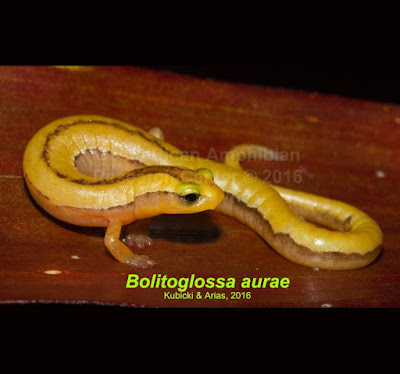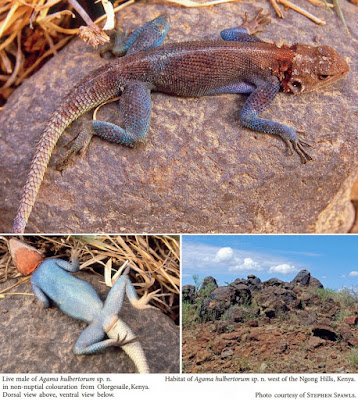[Most Recent Entries] [Calendar View]
Saturday, November 5th, 2016
| Time | Event | ||
| 4:57a | [Herpetology • 2016] Bolitoglossa aurae • A Beautiful New Yellow Salamander, Genus Bolitoglossa (Caudata: Plethodontidae), from the northeastern Slopes of the Cordillera de Talamanca, Costa Rica
Abstract A new yellow salamander belonging to the genus Bolitoglossa, subgenus Eladinea, is described from a premontane rainforest in the vicinity of Moravia de Chirripó, on the northeastern slopes of the Cordillera de Talamanca in Costa Rica at an elevation of ca. 1300 m. This new taxon is distinguished from its congeners by its chromatic and morphological characteristics, and by differentiation in DNA sequences of the mitochondrial 16S rRNA and cytochrome b genes. Keywords: Amphibia, Central America, Bolitoglossa aurae sp. nov., Bolitoglossa robinsoni clade, caudate, Eladinea, 16S rRNA, cytochrome b Bolitoglossa aurae sp. nov. Aura’s golden salamander Generic Placement. Assigned to the genus Bolitoglossa due to having fewer than 14 costal grooves and lacking a sublingual fold, and to the subgenus Eladinea based the molecular evidence presented herein. Etymology. The name “aurae” is in dedication to Aura Reyes, the wife of BK, who co-discovered the holotype and has supported and encouraged BK’s research and conservation efforts with the amphibians of Costa Rica for many years, this in addition to her own contributions to increase the knowledge of Costa Rica’s amphibians made possible through dedicating her time to accompanying BK on numerous field trips, many of which consisted of enduring prolonged periods of cold conditions while being soaking wet within the cloud forests of Costa Rica to search for elusive anuran and caudate species. The name also alludes to the Latin aureus, meaning golden, for the yellow coloration the holotype possessed in life. Distribution. Bolitoglossa aurae is known only from a single site within the Tropical Premontane Rain Forest life zone (Holdridge 1967) along the mid-elevation slopes of northeastern Cordillera de Talamanca, in the vicinity of Moravia de Chirripó, ca.1300 m (Fig. 1). Kubicki, Brian and Erick Arias. 2016. A Beautiful New Yellow Salamander, Genus Bolitoglossa (Caudata: Plethodontidae), from the northeastern Slopes of the Cordillera de Talamanca, Costa Rica. Zootaxa. 4184(2); 329–346. DOI: 10.11646/zootaxa.4184.2.5 Resumen: Se describe una nueva salamandra amarilla perteneciente al género Bolitoglossa, subgénero Eladinea, del bosque lluvioso premontano en las proximidades de Moravia de Chirripó en la vertiente noreste de la Cordillera de Talamanca en Costa Rica, a una elevación aproximada de 1300 m.s.n.m. Esta nueva especie se diferencia de sus congéneres por sus caracteristicas cromáticas, morfológicas y su diferenciación molecular en los genes mitocondriales 16S rARN y citocromo b. Palabras clave: América Central, Amphibia, Bolitoglossa aurae sp. nov., caudado, clado Bolitoglossa robinsoni, Eladinea, 16S rARN, citocromo b | ||
| 9:22a | [Fungi • 2016] Acervus stipitatus & A. globulosus • Two Novel Acervus Species extend their Distribution within Yunnan, China Abstract Acervus is a small genus in Pyronemataceae. Most of the species in this genus have been recorded from China. In the present study, two species of Acervus from Yunnan Province, in southwestern China, were investigated by using morphology and DNA sequence data. This paper introduces two new species, Acervus stipitatus and Acervus globulosus, with morphological descriptions, and compares them with morphologically similar taxa. Multi-gene phylogenetic analyses inferred from 28S, TEF1 and RPB2 sequence data strongly support the lineages for taxa of Acervus, corresponding to morphological features. We also provide a summarized comparison of the important morphological characteristics of Acervus species. Keywords: apothecia, discomycetes, inoperculate, phylogeny, taxonomy, Fungi Anusha H. Ekanayaka, Qi Zhao, Gareth E. B. Jones, En-Da Pu and Kevin D. Hyde. 2016. Two Novel Acervus Species extend their Distribution within Yunnan, China. Phytotaxa. 283(1); 74-83. DOI: 10.11646/phytotaxa.283.1.5 | ||
| 9:51a | [Herpetology • 2014] Agama hulbertorum • A New Cryptic Species of the Agama lionotus complex from south of the Ngong Hills in Kenya
Abstract East Africa, especially if including the Horn of Africa, is a centre of diversity for African Agamid lizards and harbours the endemic lineage of the Agama lionotus complex, which currently comprises nine species. Species of the complex are mainly characterized by their throat pattern in adult males, which can be used for species identification. Among them, Agama lionotus and Agama dodomae show a very distinct colouration of a blue body and a white/blue annulated tail – a colour pattern that is otherwise only known from the southern African Agama kirkii. Within the complex, Agama lionotus is the most widely distributed taxon, ranging from Ethiopia to northern Tanzania and being replaced by Agama dodomae farther south in Tanzania. Other taxa of the complex are more restricted in their distribution. In this study, specimens from a larger area south of the Ngong Hills are examined and compared with other members of the complex, because they show an overall similarity to Agama lionotus, but are distinctly smaller. Examining the morphological (62 characters) and genetical (16S, ND4, CMOS) data indicates that these specimens represent a new species. Furthermore, phylogenetic analyses support the new taxon as not closely related to Agama lionotus itself, but as a member of the complex. The new species is especially characterized by its small size. Adult males have a vertebral stripe, a blue body colouration and an annulated white/blue tail. Further typical characters are the low number of scale rows around midbody, the pear-shaped and keeled nasal scale, the minute nuchal crest, and the feebly keeled vertebral scales, followed by dorsal and lateral keeled scales. The results of this study improve our understanding of the diversity of agamid lizards in East Africa and support the value of adult male throat coloration for the identification of species within the Agama lionotus complex. Key words. Agamidae, Agama, Agama dodomae, new species, East Africa, Tanzania. Agama hulbertorum sp. n. Diagnosis: A small Agama of the A. lionotus complex. It can be identified by the following combination of characters: nasal scale pear-shaped, keeled and tubular; nasal scale in contact with the first canthus scale; nuchal crest minute, consisting of few, indistinctly raised scales; ear opening surrounded by five tufts of spiny scales, with two additional tufts on the neck; vertebral scales feebly keeled, dorsal and lateral scales keeled, ventral and gular scales smooth; dorsal and lateral caudal scales keeled, ventral caudal scales smooth; and males with one discontinuous row of precloacal pores. Males in nuptial colouration exhibit a red throat, without any pattern, a vertebral stripe, and a narrowly annulated blue and white colour pattern on the tail. Etymology: This species is named in honour of Andrea and Felix Hulbert, in recognition of their contributions to the captive breeding of African reptiles and, of course, our glorious friendship Ecology: A rupicolous lizard with individuals inhabiting rocky outcrops or solitary larger stones and rocks in an arid landscape with Acacia shrub vegetation. It is diurnal and lives in harem groups of one dominant male and several females and juveniles (A. Burmann, pers. com. 2006). Specimens at the Ngong Hills were active around noon at temperatures of about 27°C and a humidity of 60% (Burmann 2006). Philipp Wagner. 2014. A New Cryptic Species of the Agama lionotus complex from south of the Ngong Hills in Kenya. SALAMANDRA. 50(4); 187–200. |
| << Previous Day |
2016/11/05 [Calendar] |
Next Day >> |









